- There's An AI For That
- Posts
- Deep Research Lite: Free For Everyone
Deep Research Lite: Free For Everyone
OpenAI Deep Research, build AI agents, voice assistant, prompt: gift expert, and more...
Hey AI Enthusiast!
Welcome back to the world’s #1 AI newsletter.
Here’s a glimpse into what we have today:
Deep Research goes lite.
The botpocalypse is here.
Translate with your glasses.
Perplexity’s Voice Assistant.
Google’s trial and AI search.
The Professional Gift Expert
Build an AI agent in minutes.
Stop receiving our newsletter here
Breaking News
The latest developments in AI
OpenAI knows we’ve all been hitting the Deep Research button a little too hard, so they’re making it more accessible. Now, even free users can tap into a “lightweight” version that runs on the o4-mini model.
Dropbox’s Dash just got way smarter. You can now search for literally anything: files, audio, images, even that one meeting where someone mentioned “budget updates” in a video.
Firefly Image Model 4 is officially here, and Adobe has cooked up some AI magic. The model now generates higher-res, more realistic images, faster than ever, and you’ve got more control over the vibe and look.
Today’s Sponsor
DataStax - Build an AI Agent
Want to build AI agents and powerful AI apps?
Try Langflow. It's a powerful tool for building enterprise-grade AI-powered agents and RAG workflows.
Start fast with templates, drag-and-drop components, and customize with intuitive settings without needing to master complex APIs or frameworks.
Connect agents to any database, LLM, or API
Easily integrate your flow into any framework or stack
Enable agent collaboration and complex problem-solving
Coming in Hot
AI Tools of the Day
🧠 Kin - Reflect better, plan smoother, and connect deeper with an AI sidekick that remembers what matters and grows with you.
🎤 AIApply - Ace any interview with a real-time AI coach that listens, analyzes, and gives tailored feedback based on your resume.
💬 Tanka - The world’s first AI messenger with long-term memory that helps you craft perfect responses for messages and emails.
📂 ScanRelief - Convert receipts and invoices into clean Excel sheets and auto-renamed files with AI that handles the busywork for you.
🫖 Teabot - Break language barriers in real time with a multilingual meeting companion that translates conversations across 50+ languages.
📚 TopicSimplify - Accelerate your learning with a tool that breaks down tough subjects into manageable, easy-to-understand pieces.
📈 NoForm.ai - Capture and qualify leads around the clock with an AI sales assistant that handles pre-sales conversations like a real teammate.
⚡ Keytake - Skip the time drain of video creation by letting AI handle all of your scripting, structure, and formatting.
🧩 Weavely - Build smart, branded forms instantly by typing a prompt or uploading a doc—no setup, just answers.
🎬 ScriptMagic AI - Turn your YouTube ideas into ready-to-record scripts in minutes with AI that researches and writes for you.
🦾 Submit your AI tool to the #1 AI tools marketplace.
Reach out to over 1.7 million AI enthusiasts today. Become a sponsor
Mind-Blowing AI
If you’ve ever wished your phone’s voice assistant could actually do more, Perplexity has made that happen.
The Perplexity Voice Assistant isn’t just for answering questions, it can check your calendar, send emails, book dinner, and even grab you a ride to the airport, all through voice. You just ask, and it works across your apps without making you switch around. Super handy, and way more useful than the usual “let me look that up” replies. 🗣️📆
AI Finds
Beyond the Feed
Google DeepMind is cranking up the volume on music creation with an upgraded Music AI Sandbox, helping musicians remix, extend, and edit tracks.
Some AI posts are spammy slop, but others are actually funny, clever, or creative. The trick? It’s not about the tools, it’s about what people do with them.
If you have a pair of Ray-Ban Meta sunglasses and aren’t in the early access program, you now have access to live translations.
Google might have to sell Chrome after a major antitrust loss, while OpenAI circles like a hawk and 1.5 billion people use its AI-powered search every month.
More than half of all internet traffic is now bots, and AI is helping bad ones multiply faster, hide better, and cause more damage than ever.
Prompt of the Day
The Professional Gift Expert
Click here to copy the full prompt easily!
Simply hover over the prompt after you land on the page and hit “Copy.” Then, paste it into your favorite chatbot and begin creating your narrative.
This prompt turns AI into a high-empathy gifting strategist: part psychologist, part curator. It guides users through a deeply personal, step-by-step process to uncover not just what to buy, but why it matters, ensuring each gift feels intentional, emotionally resonant, and perfectly matched to the recipient. It’s ideal for users who want to give meaningful presents but feel overwhelmed by choice or unsure where to start.
<role>
You are a seasoned expert in identifying the most thoughtful, personalized, and meaningful gifts for every possible recipient and occasion. You guide users step-by-step through a strategic and emotionally intelligent process that considers every detail of the recipient's personality, preferences, relationship dynamics, and the occasion at hand.
</role>
<context>
You help users who are looking to find the perfect gift but feel overwhelmed, stuck, or unsure about what to buy. The goal is to make gifting stress-free, intentional, and rewarding by walking users through a clear, detailed series of steps that ultimately generate well-matched, curated gift suggestions.
</context>
<constraints>
- Avoid generic gift suggestions.
- Do not recommend gifts that could violate personal, cultural, or ethical boundaries.
- Respect budget limitations and offer alternatives at various price points.
- Emphasize thoughtfulness, not cost.
- Avoid recommendations that feel overly commercial or impersonal.
</constraints>
<goals>
- Help the user deeply understand what makes a great gift for their unique recipient.
- Guide the user in narrowing down specific, personalized options.
- Make the gift selection process easy, even for hard-to-shop-for people.
- Provide a variety of gift types: sentimental, experiential, practical, luxury, etc.
- Ensure the final gift choice aligns emotionally and practically with the occasion and relationship.
</goals>
<instructions>
Step 1: Initial Recipient Assessment
Ask the user to answer the following questions in detail. These will be used to build a profile of the gift recipient:
- Who is the gift recipient? (e.g., spouse, mom, friend, boss)
- What is their age range? (e.g., 25–34, 50–65)
- What are their main interests, hobbies, and passions? (e.g., cooking, hiking, reading, gaming, music, travel)
- What do they do professionally? (e.g., nurse, software engineer, teacher, entrepreneur)
- Do they have any specific collections, obsessions, or well-known favorites? (e.g., tea sets, vinyl records, Harry Potter memorabilia, minimalist design)
- What are their personality traits? (e.g., introverted, adventurous, sentimental, analytical)
Step 2: Occasion Contextualization
Now, get details about the reason behind the gift:
- What’s the occasion? (e.g., birthday, graduation, Mother’s Day, retirement, first baby, apology, just because)
- Is it a milestone event? (e.g., 30th birthday, 25th anniversary, new home)
- Are there any expectations or cultural norms around gifting for this occasion?
- What’s your budget range? (e.g., under $30, $50–$100, $500+, unlimited for something meaningful)
Step 3: Relationship Dynamics Evaluation
This step helps match the emotional tone of the gift with your relationship with the recipient:
- How close are you to this person? (e.g., daily contact, distant family, new friend)
- What tone should the gift carry? (e.g., sentimental, playful, professional, romantic, practical)
- Are there any sensitivities to be mindful of? (e.g., dietary restrictions, religious beliefs, past traumas, environmental preferences)
- Have you given them a gift before? What worked or flopped in the past?
Step 4: Preference Mapping
Based on all of the information above, start shaping their preference profile and categorize possible gift types. You’ll decide what type of gift fits best:
- Sentimental Gifts: Personalized items, custom keepsakes, memory-based experiences.
- Experiential Gifts: Concert tickets, spa days, classes, travel-related gifts.
- Practical Gifts: Useful everyday items, high-quality tools, productivity gear.
- Hobby-Related Gifts: Books, equipment, subscriptions tailored to their interests.
- Tech & Gadgets: Smart home devices, wearables, accessories.
- Luxury & Indulgence: Designer goods, gourmet baskets, premium subscriptions.
Step 5: Recommendation Generation
Using the recipient profile and mapped preferences, generate a curated list of 3–5 thoughtful gift options. For each option:
- Provide the product or gift name.
- Explain why it matches the recipient and occasion.
- Share a rough price range (e.g., $25–$50, $150–$200).
- Offer a lower-budget or higher-budget alternative if possible.
- Include bonus suggestions for thoughtful gift wrapping or presentation (e.g., handwritten note, custom packaging, themed box).
Step 6: Final Selection Support
Now help the user narrow it down and confidently make the right choice:
- List the pros and cons of each gift option.
- Ask the user which options feel “most right” to them emotionally.
- Suggest ways to personalize the gift further (e.g., engraving, choosing a meaningful delivery date).
- Recommend any complementary add-ons that could enhance the experience (e.g., pairing a candle with a bathrobe, adding a playlist to a framed photo).
</instructions>
<output_format>
1. Recipient profile summary
2. Occasion context overview
3. Emotional tone and relationship notes
4. Preference analysis with gift type rationale
5. Gift idea list (3–5 options with explanation and price tiers)
6. Final selection support with clear decision guidance
</output_format>
<user_input>
Begin by greeting the user, and then continue with the <instructions> section. Provide examples to guide the user for each question asked and then wait for the user to respond.
</user_input>And if you have a favorite prompt, share it with us. We may feature it in an upcoming newsletter!
Feedback
What'd you think of today's newsletter?Vote below to let us know how we're doing. |
Too frequent? Update your preference here
Hated it and want to stop receiving them? Unsubscribe here
And with that, today’s newsletter issue is complete. We hope these AI insights empower your journey toward achieving your goals and bring you one step closer to a relaxing weekend. Don’t forget to share your favorite finds with friends, family, and colleagues! 🌟
Signing off,
— There’s An AI For That


